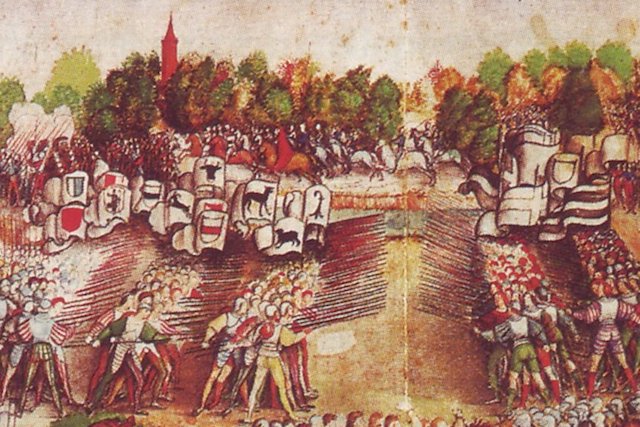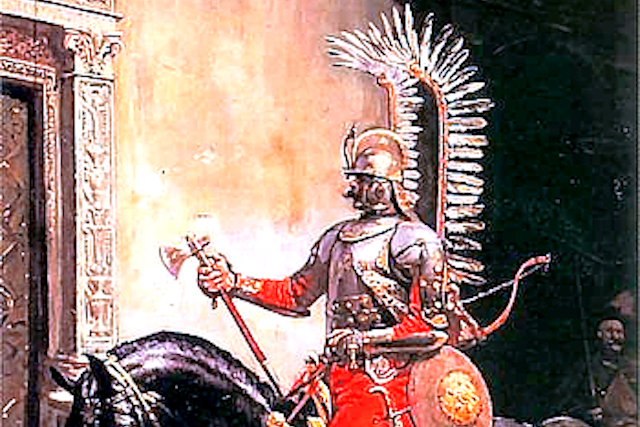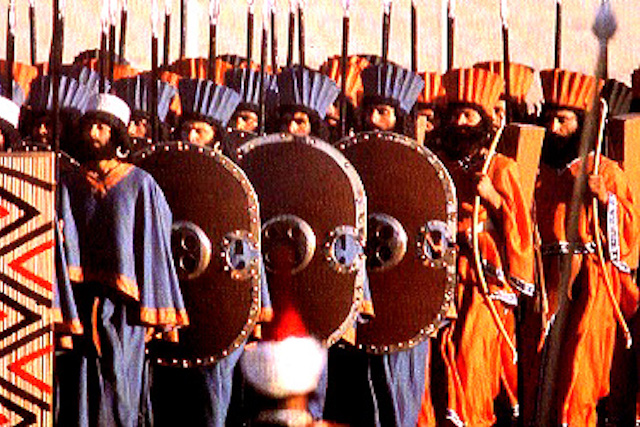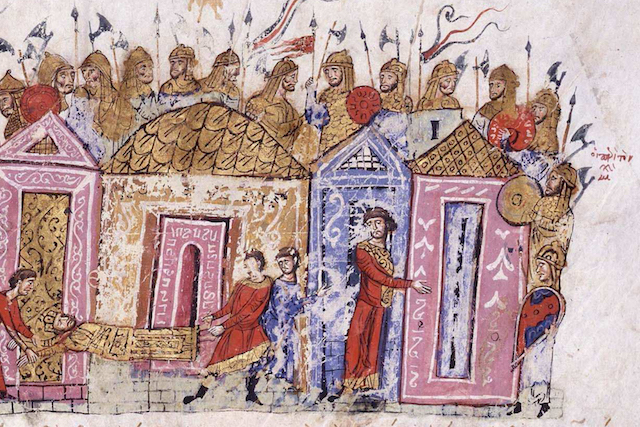Elite, special military units have always been an indispensable part of warfare throughout history. Small groups of battle-hardened, specialized fighters have often turned the tide of battle against much larger enemies, and they continue to play a pivotal role in modern warfare. Some of the best elite forces of today – like the US Navy SEALs and Russian Spetsnaz – may as well be some of the deadliest groups of people ever put together.
While the best elite forces from history won’t compare to their modern counterparts, they were still the most feared military units of their time. Some of them – like the Persian Immortals and Polish Hussars – were so good at what they did that they were instrumental in establishing and maintaining some of the largest and most successful empires in history.
10. Housecarls

Housecarls were personal troops or bodyguards of kings and chieftains across Scandinavia during the age of Vikings. They were trained better than other soldiers, as it was their job to protect the king and their families. Think of them as the Viking version of medieval knights, as many of them also happened to be some of the best fighters on the continent.
Housecarls – also called huscarls – weren’t always deployed in military roles, though with time, the kings realized their value on the battlefield. King Harold II systematically used them in combat, and they turned out to be pivotal in his victory against the forces of Harald Hardrada in 1066 – a fearsome Viking King in his own right.
9. Companion Cavalry

While Alexander is often single-handedly praised for his military victories, they’d not be possible without the capable, battle-hardened army he inherited from his father – Philip II. He was one of the earliest military leaders in history to recognize the military value of specialized, elite units of well-trained fighters. The Macedonian army had quite a few of these units, though by far the best among them was the Companion Cavalry.
Trained to be the most well-trained and well-armed cavalry unit in the Macedonian army, the Companion Cavalry was a part of some of Alexander’s greatest military victories – especially during his campaign in the east. They were chosen from nobles, landowners and other elite members of the society, and many even held administrative and political positions in the empire. On the battlefield, they were almost exclusively used as shock troops in their signature wedge formation, which was enough to break the formation of most armies they ever encountered.
8. Swiss Mercenaries

The Late Middle Ages – roughly late 13th century to the beginning of the Renaissance – was a time of warfare, plague and famine across much of Europe. While all that was definitely bad for the general populace, it was a great time for fighters-for-hire. Some of the most well-trained and successful mercenary groups in history come from this era.
Few of them, though, were considered better than mercenaries from Switzerland. Often armed with pikes or halberds, Swiss fighters trained by their local governments – also known as cantons – earned their reputation after various victories over their Austro-Hungarian emperors. At one point, they were so popular and in demand by armies across Europe that Swiss fighters often found themselves on both sides of a battle.
They were often hired as private bodyguards, too – till today, the security of Vatican City and the Pope is ceremoniously handled by Swiss pikemen (even if the actual security is still handled by a different, more modern force).
7. Samurai

While it’s difficult to pinpoint exactly when samurai fighters surfaced in Japanese society, they had established themselves as a capable, skilled fighting force by the 10th century. Originally fighters that were hired and rigorously trained by local chieftains for their private armies – as Japan was controlled by various warlords at the time – they soon rose through the ranks and eventually turned into a class of their own across Japan.
While they could be compared to elite forces from other regions – like medieval knights – samurais had a unique place in Japanese society. They’d play a major role in shaping up Japanese history, especially during the tumultuous Sengoku period – also known as the Japanese warring states’ period.
Samurais remained relevant until Japan was reunited under the Tokugawa shogunate – also known as the Edo period. By that time, there was little need for the specialized fighting skills of the samurai, so they took on more bureaucratic, political roles.
6. Mamluks

‘Mamluk’ was originally a word for slave soldiers in the Muslim world. It commonly referred to non-Arabic slaves that were trained to serve Arabic rulers throughout the region from the 9th to the 19th century. Their prominence rose during the Ayyubid era, when Mamluks were entrusted with key positions in the military as well as the bureaucracy. They quickly rose through the ranks and gained influence, eventually overthrowing the Ayyubids and establishing the Mamluk Sultanate – lasting from 1250-1517.
While they held a knight-like position in the Muslim world, they were different in the way that it was a ruling class in itself. The Mamluks were some of the most fearsome fighters of the region, though they were also capable strategists, rulers and politicians.
6. Knights

Knights started out as specialized soldiers or attendants in the early part of the middle ages – roughly 6th-10th century. By the 12th century, they had turned into an elite soldier class across Europe, though they were highly placed in civil society, too. Apart from the best training and weapons money could buy at the time, knights were also given land holdings, political positions and other perks, making them much more than just a military unit. On the battlefield, knights usually rode in on special warhorses, serving as the heavy cavalry of successful European armies up until the advent of gunpowder.
Knights have been instrumental in deciding the outcome of some of the largest military conflicts in Europe’s history, like the Crusades. While their weapons of choice were mainly lances and swords, it was really the shock factor of seeing a massive armored rider charging at you that worked for them on the battlefield.
4. Winged Hussars

‘Hussars’ – also called gusars – have their origins in Eastern Europe, mainly Serbia. Originally cavalrymen in the Byzantine Empire, these were separate groups of skilled fighters originating from across Eastern Europe that had migrated to Poland and Hungary after the Ottoman invasion. They soon earned a reputation as a capable cavalry unit across the region, where they worked as mercenaries for the better part of the 16th century. They were especially good at breaking formation and creating shock among their enemies, and were eventually recruited by the Polish army as an elite force. The military reforms of Stephen Báthory would provide them with even better equipment and training, and in return, the Hussars served them as one of the deadliest and most successful military forces in Europe for close to two centuries.
The winged hussars were the backbone of the Polish – and then the Polish-Lithuanian – empire until their disbandment in the late 18th century. Apart from their prowess in combat, they were also known for their unique look. The ‘winged’ in Winged Hussar refers to an actual set of wings on their uniform, and yes, they rode into battle like that. We’re not sure if they served an actual purpose, though it certainly made them look bigger and scarier during charges.
3. The Immortals

The Immortals were sort of the special forces of the ancient Persian Empire – also known as the Achaemenid Empire. Their total number was always 10,000, as whenever one died, another one would be trained to replace them, making it seem like an invincible, immortal unit.
Established by Cyrus II – the founder of the Achaemenid Empire – the Immortals were a heavily armored, shock unit made up of mostly Persian, Medes and Elamite warriors. Only the best fighters that had already proven their skill on the battlefield were considered for the job, as when they weren’t fighting, the Immortals were also entrusted with the security of the emperor and their family.
They played a pivotal role in the expansion of the Achaemenid Empire across the region, which – at its peak – stretched from the Balkans in the west to the Indian subcontinent in the east. We don’t have much information about what happened to them after Alexander’s invasion and death due to lack of records. We do know, though, that it was re-instituted by the Sassanids – the last imperial Persian dynasty – in 224 AD, only as a cavalry unit instead of infantry.
2. Varangian Guard

The Varangian Guard was the Byzantine version of the Praetorian Guard – a Roman-era elite force tasked with protecting the emperor. The unit was established in 988 by emperor Basil II, who was so impressed by their fighting skills during a rebellion that he decided to train them as his own elite unit of bodyguards.
The Varangians were mainly Norsemen and Anglo Saxons, which may sound weird, though Byzantine emperors found it safer to recruit foreigners than members of other, potentially-disloyal factions. In times of war, the Varangian Guard served as a special force on the lines of modern tanks, largely due to their huge size, fierce attitude and double-edged axes. It was their scary reputation combined with fighting skills that made them one of the most fearsome military units of their time.
One of the most famous members and leaders of the Varangian Guard – Harald Hardrada – even went on to become the King of Norway, and is still celebrated as one of the best fighters in the country’s history.
1. The Sacred Band Of Thebes
Established in 378 BC by a Theban general called Gorgidas, the Sacred Band of Thebes was a band of elite soldiers serving in the Theban army. It was made up of exactly 150 gay couples, making it a small-yet-efficient force of 300 soldiers. While many people have suspected that the movie 300 is based on them, it has never been confirmed. Moreover, there are some key differences between the Sacred Band and the 300 Spartans shown in the movie.
For one, and as we mentioned above, it was entirely made up of gay couples, unlike the Spartans shown in the movie. More importantly, though, Thebes was a separate kingdom from Sparta. In fact, they were often at war with each other, with the Sacred Band playing a major role in ending Spartan domination in the region.
While they were undoubtedly one of most successful and well-trained units of the time, the Sacred Band didn’t survive for a long time, as they were defeated and disbanded by the army of the Macedonian king – Philip II – and his son, Alexander in 338 BC.